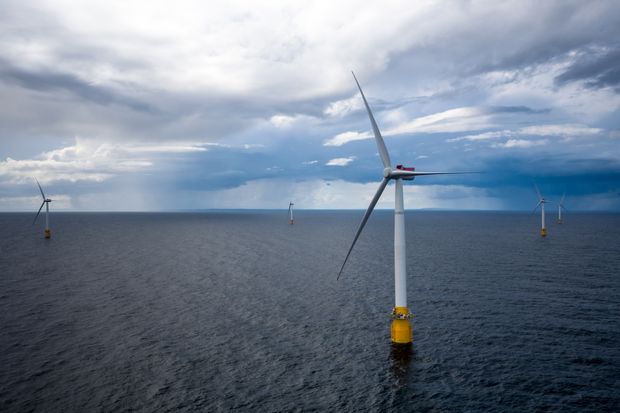Off the east coast of Scotland, five thousand-ton tower turbines float in more than 300 feet of water in the North Sea. The turbines, installed in 2017, provide electricity to about 36,000 households per year.
Wind farms have been built both onshore and offshore for decades, but Hywind Scotland, operated by the Norwegian oil giant, is the only company in the world with a wind farm.
Equinor AS
Ah, this is the first time we have been at sea. Instead of steel pipes buried in the seabed, the turbines are housed in cylindrical buoys attached to the seabed with mooring posts. This approach promises to allow wind farms to exploit unused parts of the coastline for renewable energy sources in much deeper waters, where the winds are often stronger.
Equinor believes there are many countries where floating wind turbines could be the best option for renewable energy production. In some places, such as Japan, South Korea and the United States, a sharp drop in the continental shelf means that the water is too deep for stationary wind turbines, which are limited to a depth of about 60 meters, or just under 200 feet.
Subscribe to the newsletter
The future of everything
Discover how innovation and technology are changing the way we live, work and play.
There is increasing interest in this technology as governments seek to reduce carbon dioxide emissions into the atmosphere. The 2015 Paris climate agreement, in which governments agreed to limit the rise in global temperature to less than 2 degrees Celsius with the goal of limiting it to 1.5 degrees Celsius, focused on limiting emissions, to which renewables contribute.
Yet floating wind power is nearly twice as expensive as fixed offshore wind, which requires an average price of $84 per megawatt-hour of electricity to make projects cost-effective, according to industry group Global Wind Energy Council. There are dozens of designs of floating platforms in the works, making the cost savings associated with standardization and mass production impossible. The longer cables needed to feed energy back to land can also drive up costs. The internal rate of return, which is a measure of return on investment, is about 10% for fixed wind turbines and is not yet known for floating turbines.

Launched in 2017, Highwind Scotland now has around 36,000 homes in the UK.
Photo:
Statoil/Oyvind Gravas/Xinhua/Cumapress
Another obstacle is the slow pace at which governments develop policies to enable project implementation.
“We start where the government feels like it and where there is a need for energy that cannot be met by obvious and much cheaper options such as onshore wind, solar and, to some extent, offshore wind,” says Sebastian Bringsward, head of floating wind development at Equinor.
According to Bringsward, some governments understand that floating wind farms may be their only option to meet their CO2 reduction targets, especially if they have little space for onshore solar and wind projects. Whether fixed or floating offshore wind farms, they do not face the same strong public opposition in terms of their impact on the environment and landscape. They are not visible from shore more than 30 miles away. Cables can be buried as far as the power plant itself, but this may be more difficult if the cable ends up on land in a residential area.
Offshore wind energy
Floating offshore wind turbines may soon power communities whose coastal waters are too deep for turbines anchored to the seabed. Equinor operates the world’s first floating wind farm, which began operation off the coast of Scotland in 2017. The floating version is more expensive than fixed turbines, but can be deployed in deeper waters where the wind is stronger and more stable.

Floating ballast structure
Five turbines supply electricity to about 36,000 households in the United Kingdom.
Swim in over 300 feet of water.

Floating ballast structure
Five turbines supply electricity to about 36,000 households in the United Kingdom.
Swim in over 300 feet of water.

Floating ballast structure
Five turbines supply electricity to about 36,000 households in the United Kingdom.
Swim in over 300 feet of water.

Floating ballast structure
Swim in over 300 feet of water.
Five turbines supply electricity to about 36,000 households in the United Kingdom.
Some oil and gas companies looking to expand their use of renewable energy see floating wind turbines as a natural extension of their expertise after years of building floating oil and gas platforms to extract fossil fuels from the depths of the sea.
Energy giants, including the French
Total SE
и
Royal Dutch Corps
PLC is investing in line with its plans to reduce dependence on oil and increase spending on low-carbon energy. In 2019, Shell acquired Eolfi SA, a Paris-based floating wind turbine company. Utilities already active in wind power are also testing floating technologies, including the
Iberdrola SA
and Germany
RWE Group.
Both companies are involved in pilot projects with simple turbines that are expected to start in Europe in the next two years.
There are many possibilities. Countries such as Japan, South Korea, the United Kingdom, Spain and some U.S. states have plans to place wind turbines offshore. Some regions are setting targets for offshore wind, including the European Union, which has set a goal of increasing wind capacity fivefold to 60 gigawatts by 2030. According to Equinor, some of these installations will be connected to floating wind turbines.
“Low-height wind turbines with a fixed base have been installed,” said Bruno Geschier, director of sales and marketing for French company Ideol SA, which designs and builds floating foundations for the turbines. The company’s technology has been used in pilot projects with one turbine in France and Japan since 2018.
President Biden’s decision to reengage the United States in the Paris Agreement and plans to invest more in green energy have also led to optimism about floating wind turbines.
“The willingness of governments to make sites accessible is an important factor that is one of the constraints to the development of the U.S. market,” said Joao Metelo, managing director of the California company Principle Power Inc. which designs and manufactures floating platforms.

Hywind Scotland’s turbines will be assembled in 2017 before being transported to their destination in the North Sea in approximately 300 feet of deep water.
Photo:
Carina Johansen/Bloomberg
The company has developed a three-column semi-submersible platform that distributes the weight of the turbine and stabilizes it. The company is considering future projects, including at depths greater than 3,000 feet. In 2018, California’s Redwood Coast Power Authority selected a consortium consisting of Principle Power, Norwegian oil services company Aker Solutions AS and the renewable energy division of Portugal’s largest utility, Aker Solutions.
Energias de Portugal SA,
enter into a public-private partnership for the planned floating wind turbine project.
Further offshore, the wind blows stronger and more evenly, so floating offshore wind projects can produce more electricity than stationary wind projects. Equinor’s Scottish Hywind project has reached 55% of its potential capacity by 2019, according to the International Energy Agency, compared to 29-52% for stationary offshore wind projects, while solar photovoltaics account for less than half of that.
“About 60 to 80 percent of the best wind resources near demand centers are in areas where the water is more than 60 meters deep,” says Geschel de Ideol.
According to GWEC, several floating wind farms are expected to be operational on a commercial scale by 2025, including in Spain, Italy and South Korea.
One such project is Hywind Tampen, an Equinor project off the Norwegian coast that will supply electricity to some of the company’s offshore oil and gas platforms starting next year. Equinor uses a technology in which a floating cylindrical buoy containing a wind turbine is weighted so that the entire structure floats vertically.
Governments are expected to auction off areas for seabed development later this year. Because of the depth of the water, proposals for floating wind turbines will likely be implemented off the coasts of France, South Korea, Norway and other countries.
As the size of the project increases, the cost is expected to decrease.
Henrik Stisdal, chairman of GWEC’s Offshore Floating Wind Turbine Working Group, expects the cost of floating turbines to be comparable to that of fixed turbines over the next decade, thanks to the same subsidy programs that have helped drive down the cost of fixed turbines.
“The most important thing to bring down the price of floating wind turbines and become really competitive is volume,” Stisdahl says.
Email Sarah McFarlane at [email protected].
Copyright ©2020 Dow Jones & Company, Inc. All rights reserved. 87990cbe856818d5eddac44c7b1cdeb8
Frequently asked questions
Do wind turbines use renewable energy?
A wind turbine produces reliable, inexpensive, and clean energy A single wind turbine can be enough to produce energy for a household. Because wind is a clean and renewable energy source, turbines produce energy without using fossil fuels.
What are the environmental benefits of wind turbines?
Wind turbines do not emit emissions that can pollute the air or water (with some exceptions) and do not require water for cooling. Wind turbines can also reduce the amount of electricity generated by fossil fuels, resulting in an overall decrease in air pollution and carbon dioxide emissions.
What kind of energy do wind turbines produce?
Click here to see the inside of the wind turbine. The wind direction rotates the nacelle so that it collides with the wind. Wind energy (called kinetic energy) makes the turbine blades spin around the rotor (generating mechanical energy).




